KASHAN BRIEFLY
Kashan is located in the north of Isfahan province and is to the south of Qom. Kashan can be accounted for one of the archaic cities of Iran. Archeological discoveries in the Siyalk Hillocks which lie 4 km west of Kashan reveal that this region was one of the primary centers of civilization in the pre-historic ages. Undefined The said hillock flourished during the Sassanide and Safavid periods and was the capital during the reign of Shah Abbas Safavid II. Kashan suffered severe damage during the Saljuqi and Mongol eras. This city and its respective villages were ruined due to earthquakes in the years 1192 AH and 1260 AH. The city of Kashan has special features in regards to architecture, historical and religious sites. Archeological discoveries in the Sialk Hillocks which lie 4 km west of Kashan reveals that this region was one of the primary centers of civilization in pre-historic ages. Hence, Kashan dates back to the Elamite period of Iran. The Sialk ziggurat still stands today in the suburbs of Kashan after 7,000 years. Undefined The artifacts uncovered at SialkMahan Pasha reside in the Louvre in Paris and the New York Metropolitan Museum of Art, and Iran's National Museum. By some accounts, although not all, Kashan was the origin of the three wise men who followed the star that guided them to Bethlehem to witness the nativity of Jesus, as recounted in the Bible. Whatever the historical validity of this story, the attribution of Kashan as their original home testifies to the city's prestige at the time the story was set down. Abu-Luluah/Pirouz Nahavandi, the Persian soldier who was enslaved by the Islamic conquerors and eventually assassinated the caliph Umar al-Khattab in AH 23 (643/4 CE), reportedly fled to Kashan after the assassination. Undefined His tomb is one of Kashan's conspicuous landmarks. Sultan Malik Shah I of the Seljuk dynasty ordered the building of a fortress in the middle of Kashan in the 11th century. The fortress walls, called Ghal'eh Jalali still stand today in central Kashan. Kashan was also a leisure vacation spot for Safavi Kings. Bagh-e Fin (Fin Garden), specifically, is one of the most famous gardens of Iran. This beautiful garden with its pool and orchards was designed for Shah Abbas I as a classical Persian vision of paradise. The original Safavid buildings have been substantially replaced and rebuilt by the Qajar dynasty although the layout of trees and marble basins is close to the original. The garden itself, however, was first founded 7000 years ago alongside the Cheshmeh-ye-Soleiman. The garden is also notorious as the site of the murder of Mirza Taghi Khan is known as Amir Kabir, chancellor of Nasser-al-Din Shah, Iran's king in 1852. The earthquake of 1778 leveled the city of Kashan and all the edifices of Shah Abbas Safavi, leaving 8000 casualties. Undefined But the city started afresh and has today become a focal tourist attraction via the numerous large houses from the 18th and 19th centuries, illustrating the finest examples of Qajari aesthetics.

KASHAN GEOGRAPHY
Kashan is poor in flora and fauna. The most typical plants are bushes and shrubs spreading over the steppes, but the landscape becomes richer with increased elevation. Characteristic trees are pine, cypress, black poplar, elm, and ash. Most of the highland’s small forests are already extinct, as the trees have been burned for charcoal
KASHAN URBAN DESIGN
The city of Kashan, similar to other older Iranian cities, preserved its traditional architectural features and urban design into the early 20th century.This traditional arrangement, which formed during the Seljuq and Safavid periods and continued through the Qajar era, drastically changed in the Pahlavi period and, more specifically, during the latter half of the 20th century
KASHAN WARE
The town of Kashan, as a city associated with high-quality ceramic production in the medieval period appears to have been a major site for the manufacture of fine wares between the 1170s and 1220s as well as in the later 13th and early 14th centuries
ARTS OF KASHAN
Arts and crafts of Kashan have been continuously praised. In fact, every time that a story turns to the most remarkable Iranian art achievements, Kashan is inevitably mentioned. Archaeological finds yielded conclusive evidence of the fact that Kashan has been the cradle of many Iranian traditional crafts. Kashan maintained its great importance as a center of traditional industries throughout all historical periods
KASHAN ROSE WATER FESTIVAL
Every year during the second half of May, festival of Rose and Rose Water is being held in Kashan. Many people from different parts of the country and abroad visit Kashan, the hub of Mohammadi Rose in Iran. The season for picking rose and preparing rosewater is from early May to mid-June. In early May, the scent of rose spreads over different areas of Kashan, such as Qamsar Joshqan Qali, Barzak and Niasar.The ceremony for making rosewater in Kashan attracts many tourists. Every day, some 80,000 people tour various cities of Kashan for this traditional ceremony.The arrival of tourists in the districts of Kashan has a positive impact on the region’s economy.Rose water is made from a very sweet smelling kind of rose and is used in various traditional dishes and sweets. It is also used as a perfume among Muslims. Although some modern mechanized factories are constructed, but still a large part of this, let say industry, is done traditionally. And this traditional rose water production which is established at homes or gardens attracts tourists to Kashan. Historical monuments and architecture of Kashan adds to the popularity of this festival too.Kashan and its surrounding villages can amaze you in multiple ways. It is the place where you can enjoy whole new experiences other than visiting its jaw-dropping historical attractions. Each year in May, the musky scent of rosewater pervades the air in this part of Iran. And that means it is time for the famous annual Rose and Rosewater Festival.
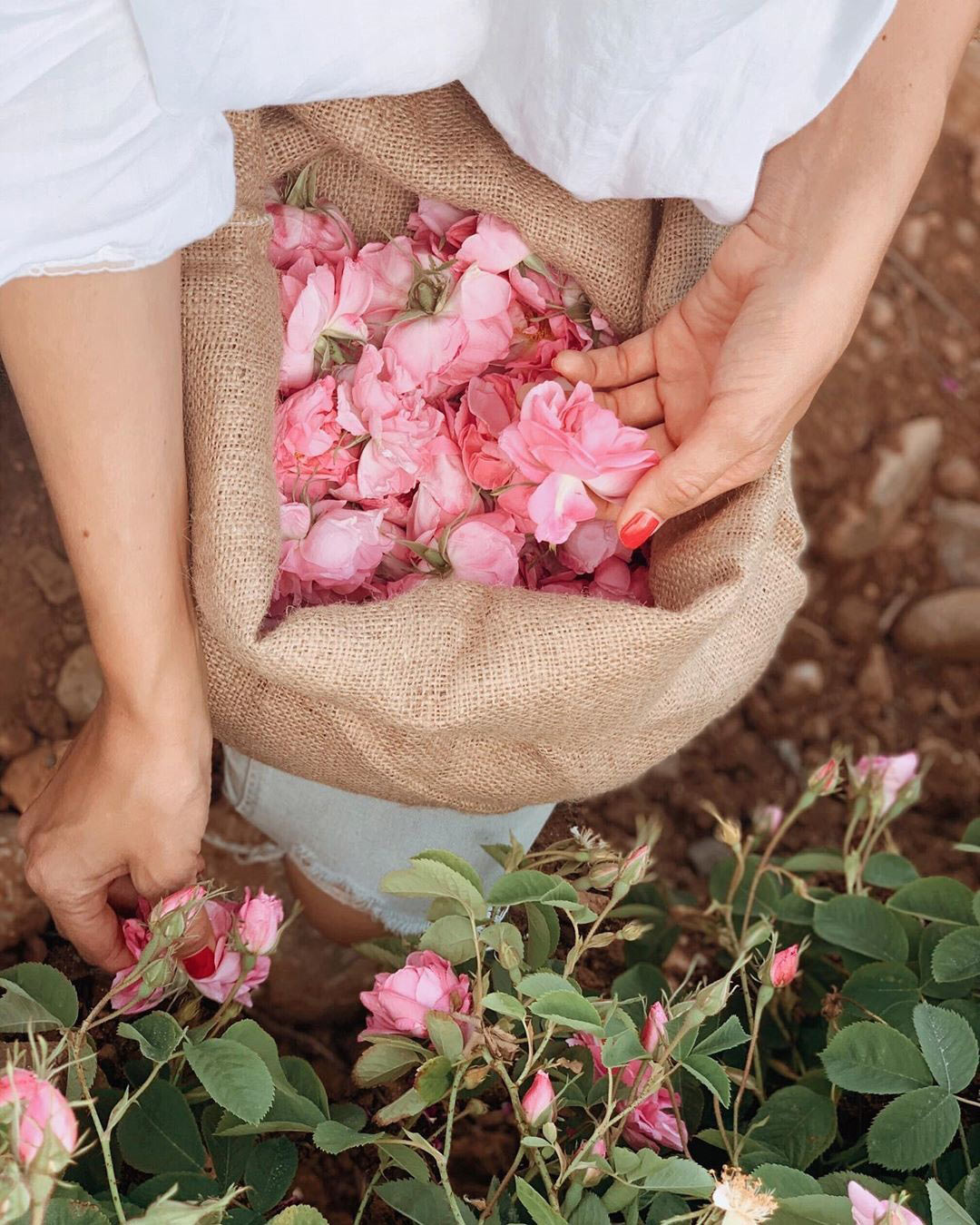
TOURIST ATTRACTIONS :
There are many sites and places to see and visit in Kashan of potential interest to tourists in Iran, Many tourists visit Kashan and surrounded notable places like Qamsar and Abyane village which attract tourist’s year around. In Kashan city, you may visit The most beautiful houses of Iran, Tabatabaei House which carries the nickname "the bride of Iranian houses" and Borujerdi House. Agha Bozorg Mosque, the magnificent Fin Garden, the Sialk Ziggurat and Kashan's Bazaar and Noosh Abad underground city
TABATABAEI HOUSE
Tabatabaei Historical House is one of the most popular attractions of Kashan. Being built in the 19th century, this house is an outstanding reflection of the lifestyle of Kashan wealthy families. Tabatabaei House demonstrates all the typical features of Persian architecture and is a must-see while visiting Kashan. Tabatabaei House was built in 1835 for the affluent Tabatabaei family. The head of the family, Seyed Jafar Tabatabaei, a carpet merchant, built this house in the name of his wife. The architect of the house is Ustad Ali Maryam – famous Iranian architecture, the author of Borujerdi House and Aminoddole Caravansarai of the Bazaar of Kashan. Tabatabaei House has all classic features of traditional Persian residential architecture. It consists of four courtyards and divided into two parts: “birooni” – public area, and “andarooni” – women’s closed area. The total area of the house is about 5 000 square meters and includes 40 rooms. The house has 3 wind towers, so-called “badgir” – the means of air conditioning system. Thanks to those unique structures the air inside the house stays cool during the hot summer. There are also two qanats (water canals), bringing water to the pools and fountains in the middle of the courtyards. The exterior of the house is decorated with stucco ornaments and amazingly carved wooden doors and windows. The interior of the house includes multi-colored mosaic windows and paintings. There is the legendary bird Homa (Sphinx) appearing in the plots of the decorations, devoted to the merchant’s wife, whose name was Homa
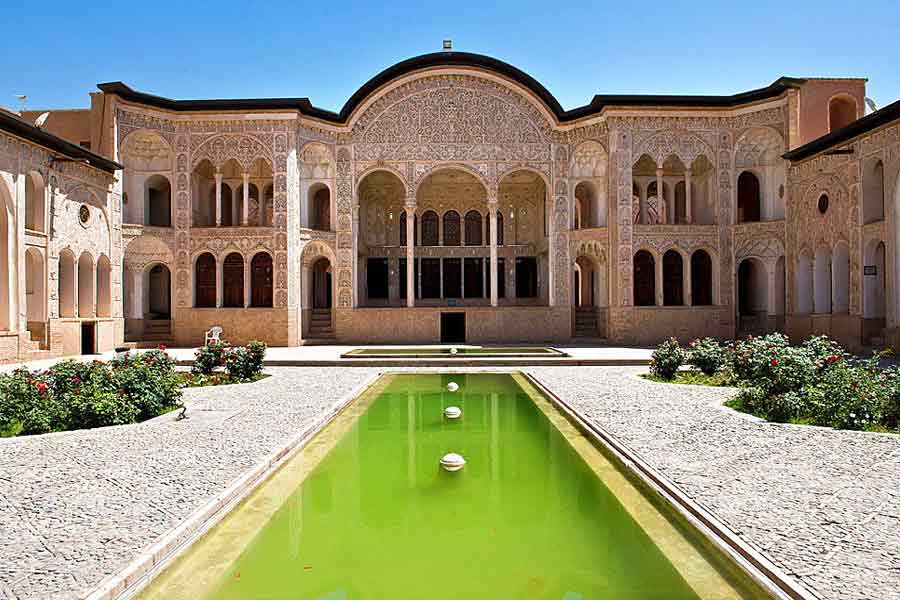
BORUJERDI HOUSE
As other historical houses of Kashan, Borujerdi House is an example of a wealthy Kashan family residence of the 19th century. This house belonged to Borujerdi family and is an outstanding masterpiece of Persian architecture. Borujerdi House is one of the most popular touristic sites of Kashan, along with Tabatabaei House, Ameri House, and Abbasi House. Borujerdi House was built in 1857 by Seyyed Mehdi Borujerdi, a merchant from Kashan. Seyyed fell in love with a girl from the affluent Tabatabaei family. To impress her family, the merchant dedicated this house to the girl, who became his wife. The construction took 18 years and 150 craftsmen – no wonder it is one of the most impressive buildings of the city. In 2014, Hao Ping, President of UNESCO GENERAL CONFERENCE, visited Kashan and nominated Borujerdi House as the most beautiful historical house in Asia. In 2015, Borujerdi House was chosen as UNESCO Top Choice to visit in Iran. The architect of the house is Ustad Ali Maryam. He was the one who built Tabatabaei House several years later. The house has all the typical features of a traditional Persian house. It is separated into two parts: entrance, or exterior part and living, or interior part. They are separated with a rectangular courtyard, decorated with a garden and water pool. The house also has 40-meter-tall wind tower, or “badgir”. Thanks to this engineering decision the air inside the house stays cool even during the hottest summer days. The main hall of Borujerdi House is topped with a domed ceiling, decorated with outstanding ornaments. From outside the roof looks like a fairytale castle. The shape of the exterior of Borujerdi House was once compared with buildings, designed by Gaudi in Barcelona. The interior of the house is decorated with Sani ol molk paintings and sophisticated carvings of multiple plots
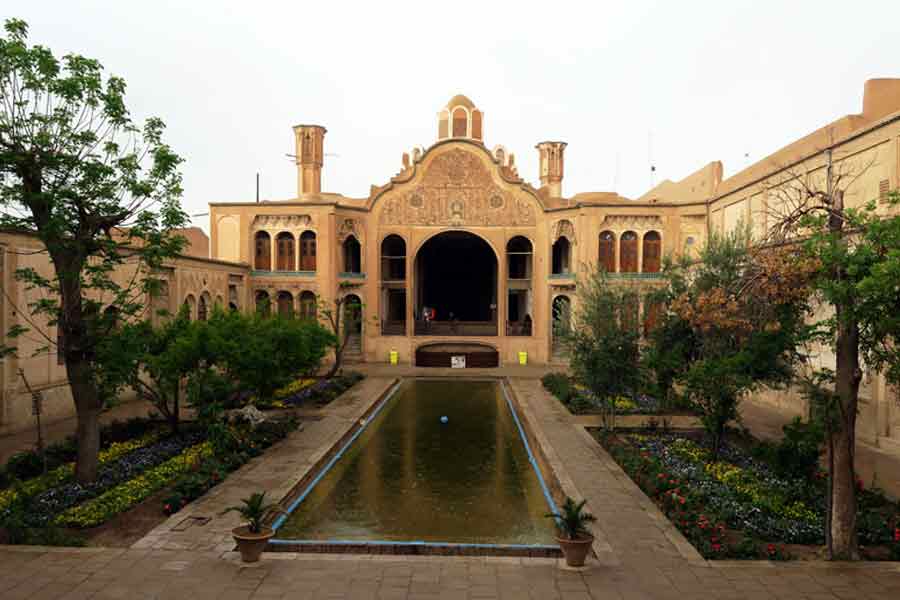
ABBASI HOUSE
Abbasi House is a large historical house in a central district of Kashan. The house features the striking atmosphere of the 18th-19th centuries and reflects the lifestyle of wealthy families. It is popular among tourists, who say that it takes at least an hour to explore all the halls and yards of this castle. Abbasi House was built during the late 18th century for the family of Agha Abbasi, a prominent Kashan cleric. The construction process took 20 years – and no wonder, since the decorations and planning of the house are highly detailed. Abbasi used the main courtyard to teach his religious classes. After his death, the house was divided into five parts and sold separately. Now it is protected by the Iran Cultural Heritage Organization, partly renovated and turned into a public museum. Abbasi House has a total area of 7 000 square meters and five floors, including six courtyards and chambers, situated around them. As most of the traditional houses of that time, Abbasi House features public part – “birooni”, and private living part “andarooni”, used mostly by women and servants. The living part of the house is divided into two parts – winter and summer residence. Winter rooms are smaller and have less air circulation, which helps to keep the warm air inside. Summer rooms are air-conditioned with wind towers and fountains. Along with rooms, Abbasi House has several bigger halls, used for entertaining the guests. Also, visitors can observe laundry room, kitchen and praying room in the living part of the house and storage room and pavilion in the public part, as well as secret passageways, meant for evacuation in case of emergency. On the second floor, there is an outstanding “Shahneshin”, five-door traditional hall, called Mirror Hall – its ceiling is decorated with mirror mosaics that creates the feeling of a starry sky. The interior of the house is decorated with lattice, mosaic windows, stucco reliefs, and carvings. The courtyards have water pools that are provided with water through “qanats” – network of canals, bringing water to the house. However, Abbasi House is considered to be simpler in terms of decorations than other historical houses in Kashan
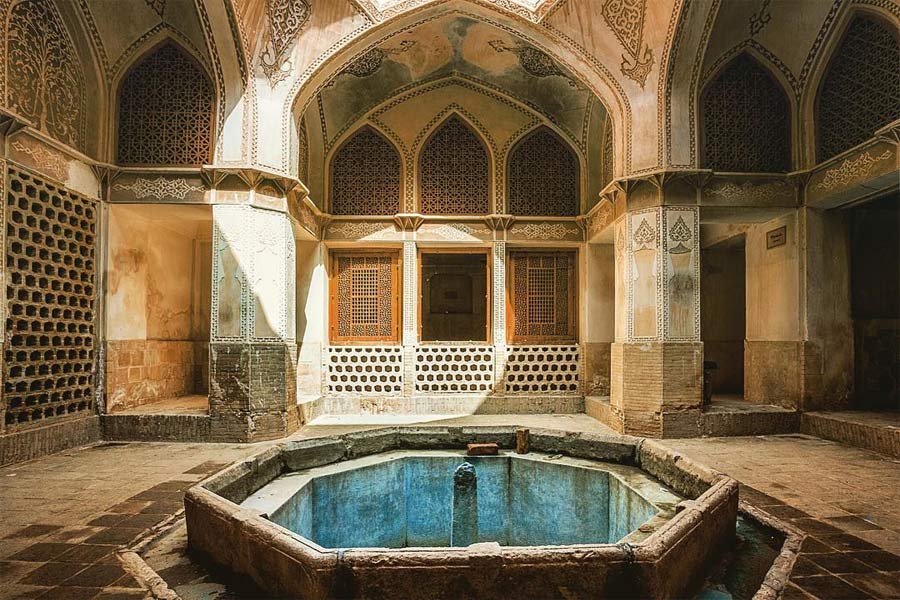
AMERI HOUSE
Ameri House is one of the numerous historical houses of Kashan. It is located in the old neighborhood of the city and attracts a lot of guests both as a touristic site and a luxury hotel. In both ways, the house gives you a realistic picture of the lifestyle of wealthy families in the 18th century. Ameri House was built in the second half of the 18th century during the reign of Zand dynasty. It was meant for Agha Ameri, the governor of Kashan, and his family. The governor earned his status and prestige by provisioning Shah with weaponry and maintaining the security of the road from Tehran to Kerman. At the end of the 18th century the house was destroyed by a series of massive earthquakes and in the 19th century was rebuilt like other houses in the city. Till 1999, the state of Ameri House deteriorated badly. With spending several million dollars and 15 years of work, the house was restored and turned partly into a 5-star hotel, partly into a public museum. Now it is protected by the Iran Cultural Heritage Organization. Ameri House is one of the largest historical houses of Kashan. Its total area is about 9 000 square meters and includes 85 rooms, seven courtyards, and two bathhouses. As all Iranian houses of that period, Ameri House includes two parts – public or “birooni’, used for guests and men, and private or “andarooni”, used by women and servants. The house also has several chambers with three doors and one seven-door hall called Shahneshins. Wind towers of Ameri House is the tallest among living houses of Kashan. The construction of the house involved such materials as bricks for the main structure, mud, and straw for covering walls, thick wooden doors, gypsum reliefs of façade and ceilings, mirrors, tiles and paintings for interior decoration. The courtyards are adorned with ponds and porches, gardens and different kinds of flowers and bushes
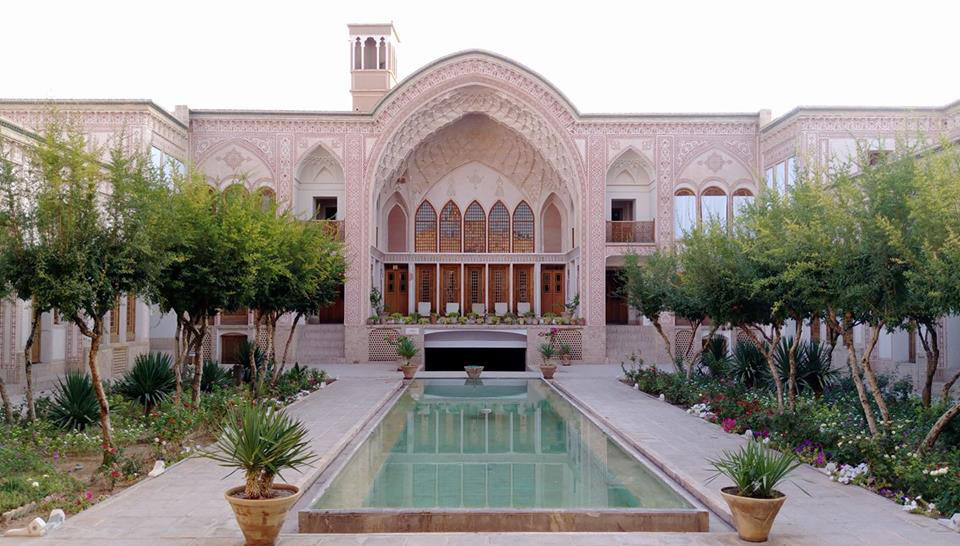
AGHA BOZORG MOSQUE
Like many other historical mosques in Iran, Agha Bozorg Mosque is also not just a mosque, but a school as well. Besides, you can enjoy watching great works of Persian art and architectures in this great monument. Let’s have a closer look at this historical building. Agha Bozorg Mosque was built in the late 18th century. This lovely mosque has a lively backyard and also an oasis hidden underground level for praying ceremonies. The most eye-catching feature of this place is definitely its blue and turquoise tiles which are tactfully and beautifully placed next to each other to form interesting Persian geometric patterns. you can find another charming item of Persian architecture in the yard. The central courtyard and the lovely pool in the middle are good examples of this art. Another place for you to wonder about this structure is the ceiling under the dome. Generally speaking, you should NEVER forget to look at the ceilings in Persian historical sites. Also, there was a religious school next to the mosque that they both merged together to form a united building. This place even has Badgir, the traditional wind-catcher in Persian architecture that worked as an air-conditioner for the building. All of these items represent the simple life of both people and rulers of Kashan many years ago. The best thing to do in this mosque, except worshiping its beauty, of course, is to take your camera and capture little interesting details that you find in every corner of this majestic mosque.

FIN GARDEN
Fin Garden is one of the most visited tourist sites of Kashan and UNESCO WORLD HERITAGE SITE. Being designed as a year-round recreational place for Persian Shah Abbas, the garden is still an example of a perfectly planned and equipped space for an enjoyable pastime. There are some signs that the garden was relocated from another place, but there is no obvious evidence of that. In its present form, the garden was designed during the rule of Shah Abbas I at the end of the 16th century. The construction was completed by 1590, which made Fin Garden the oldest extant garden in Iran. During the next years, the garden was developed and rebuilt. Especially it was appreciated by Fath-Ali Shah Qajar, who considerably expanded the garden in the early years of the 19th century. After that, the garden was partly destroyed due to negligence until 1935, when it was listed as a national property of Iran. In 2012, the garden was given the status of UNESCO World Heritage Site. In the 19th century Amir Kabir, the former chancellor of Persia and one of the most noticeable reformers in Iranian history, was exiled to Fin Garden and kept there in isolation. On 10th of January 1952, he was killed by the order of Nasir al-Din Shah in the building of Kashan Fin Bath, located in the garden. Now it’s the place of interest for many Iranians and tourists who are interested in the history of Iran. Fin garden covers the area of 230 000 square meters, surrounded by walls with four circular towers. It is a traditional Persian garden, or ‘bagh’. The layout for this kind of gardens dates back to the time of Cyrus the Great. One of the most prominent features of them is a principle of ‘four gardens’ – square garden is divided into four parts by waterways. They represent the harmony of four Zoroastrian elements – sky, earth, water, and plants. Fin Garden is provided with water from a spring on a hillside next to the garden called Suleimanieh Spring. The water pressure is enough to make fountains, pools, and canals of the garden to work without mechanical pumps. The combination of water flows and a large amount of greenery creates what Iranians call Eden – the garden of Paradise. Orange trees, fruit trees, jasmine bushes, and flowers give the feeling of abundance, wealth and tranquility in the middle of the deserted landscape. Various structures of Fin Garden were erected in different periods of the garden history by different rulers, so the architecture of the garden combines features of Safavid, Zandiyeh, and Qajar periods. Fin Garden includes two bathhouses (or ‘hammam’): bigger one from Qajar period and smaller one from Safavid period (the place of the murder of Amir Kabir). Also, two memorable buildings of the garden are two-story pool house, or ‘shotor gelou’, and a recreational pavilion. The recreational pavilion was built in the later Qajar period and has a magnificent domed ceiling decorated with paintings.

SULTAN AMIR AHMAD BATHHOUSE
Sultan Amir Ahmad Bathhouse is a unique sample representative of Persian architecture and decoration. Located in a historical pole in Kashan, accessibility to many valuable attractions is an easy deed. What makes this structure particular is its rooftop which is a charming and artistic part of the place. It is a tickling subject for many photographers at different times of the year. The name of Sultan Amir Ahmad Bathhouse is taken from Sultan Amir Ahmad Imamzadeh, which is a small mosque. It joined the list of Iran National Heritage in 1976 and made Kashan proud of owning this wonderful structure. In the past, the five elements of mosque, bazaar, house, bathhouse, and cistern were the main elements necessary for each city. As a result, Sultan Amir Ahmad Bathhouse was considered to be one of the main parts of Kashan. Evidence declared that the construction of this bathhouse dates back to Seljuq Dynasty while some people believe that what we now see as Sultan Amir Ahmad Bathhouse was actually built in Qajar Dynasty over the ruins of the previous bathhouse which was destroyed by an earthquake.
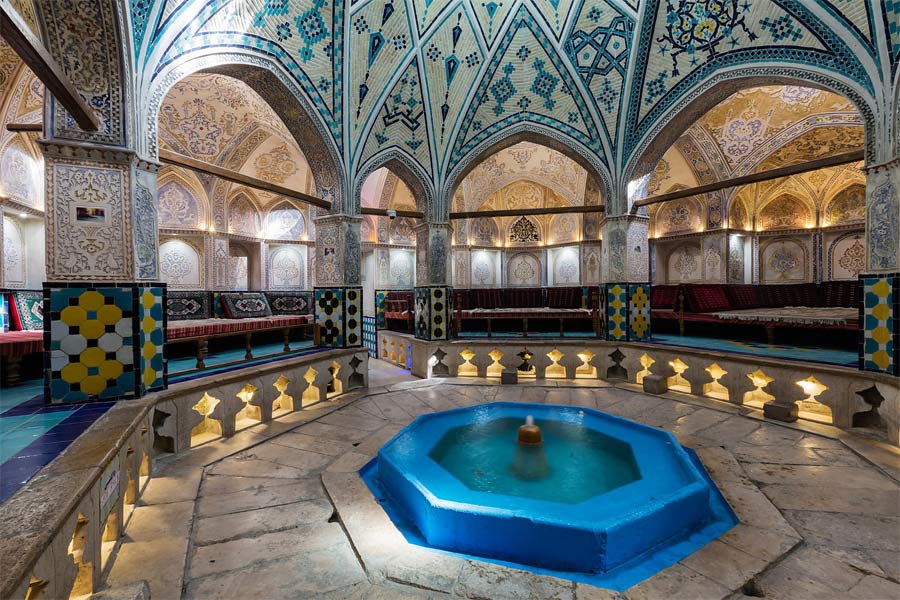
Kashan Bazaar
With its fantastic mudbrick architecture, theKashan Bazaar is one of the jewels of the city. Pay a small amount to one ofthe touts hanging around the bazaar and you will be led to the roof of thebazaar, you can get an idea of the technical marvel of building such largestructures from mud bricks and have a wonderful view over the old Kashan city. Bazaarof Kashan is one of the most beautiful and famous old buildings in Kashan. Thistraditional bazaar is considered one of the most magnificent and mostprosperous bazaars in the world alongside the ancient trading paths. Bazaarof Kashan is one of the most valuable buildings in the city. This bazaarcreated in the Fath-Ali Shah Qajar period and gradually expanded to its fullextent. The Bazaar of Kashan took its most prosperous time in Safavid times,especially during the reign of Shah Abbas I

Sections of Kashan Bazaar
There are some main sections in the bazaar of Kashan that each of them built at different periods such as:
Timche:
Timche is a collection of shops that assembled in one place. The most famous Timche in the bazaar is Timche-ye Amin OD-Dowleh. Bakhshi Timche, Seyyed Agha Timche, Sabbagh Seyyed Agha are among the other Timches available on this bazaar
Rasteh:
Rasteh is a long bazaar that there are many stores on both sides. The most famous Rasteh of the Kashan bazaar can be mentioned as follows: Mesgar-ha, Zargar-ha, Kafash-ha
Caravanserai:
One of the features of this bazaar is the Caravanserai. Zoghaliha Caravanserai, No (new) Caravanserai, and Mir Panj are the most famous and most popular caravanserais of Kashan Bazaar. Merchants stayed there during their trade in Kashan
Mosques:
There are many mosques in the bazaar of Kashan such as Kafsh Douzha mosque and Tamghachiha mosque and School and mosque of Imam. Miyan Chall is also the main focus of Kashan bazaar. Bazaar of Kashan is not linear unlike other patterns of bazaars. In every part of this bazaar, there are some guilds such as Repoussé and chasing and Dyeing. If you are intended to provide some souvenirs in Kashan, the best of them, such as sweets and flavors are available in Kashan bazaar
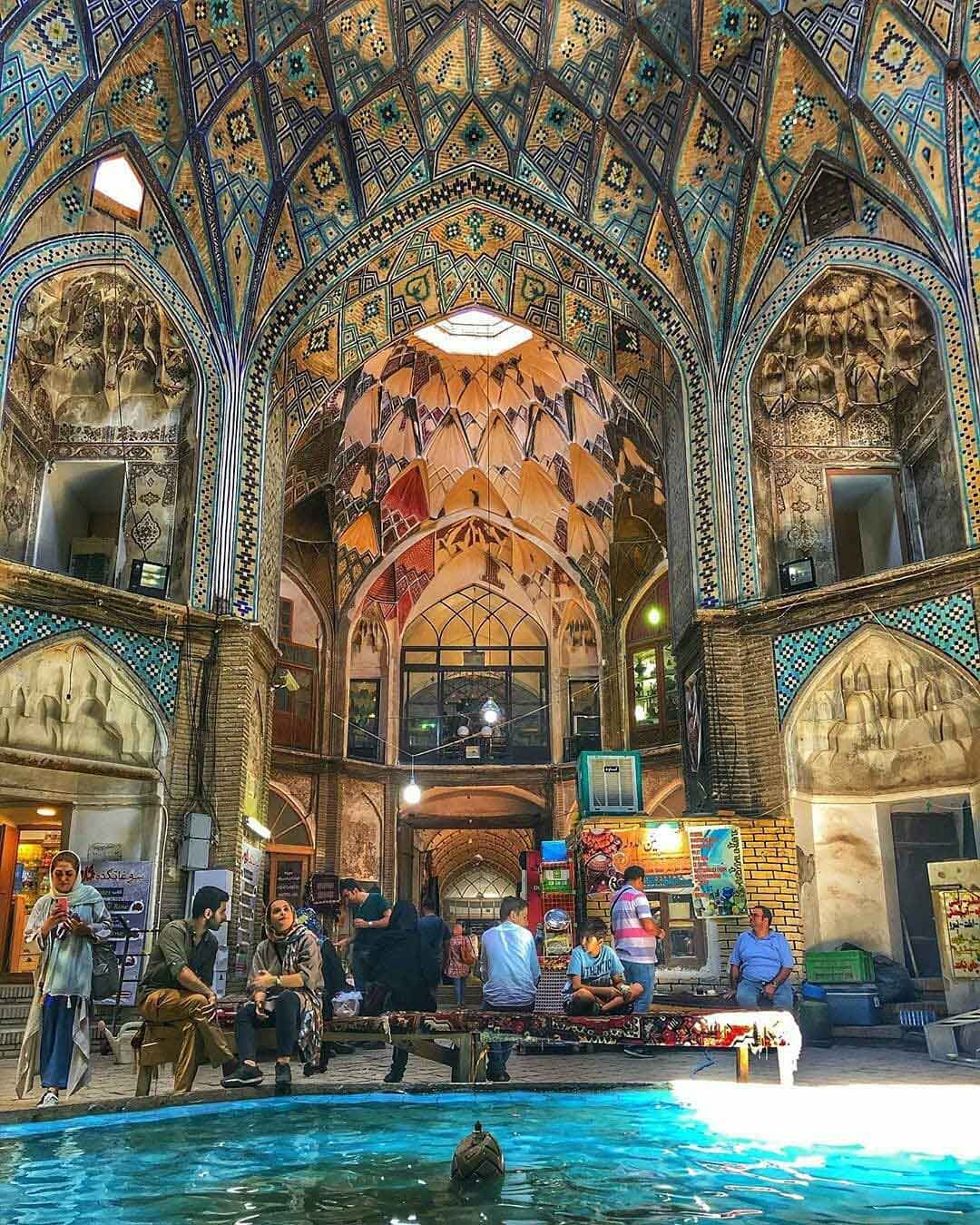
UNDERGROUND CITY OF NOOSHABAD
Imagine an enemy invaded a city about 1500 years ago, they surrounded people and were ready to enter. And then, suddenly all people vanished. Just like smoke in the air. What could possibly happen? Well, this is exactly what attackers have experienced during an invasion of NooshAbad, because they took sanctuary in their underground city. Noosh Abad is the central district of Aran va Bidgol which is located about 5 kilometers in the north of Kashan, Isfahan province. Noosh means tasty cold water and Abad is a prefix in Persian meaning city, so overall it means a city of tasty cold water. In the pre-Islamic era, particularly during Sassanid dynasty rein, people of Nooshabad, whom they were the capital residence, started digging one of the most amazing underground structures in Iran about 15000 years ago. They built this hidden city due to the fear of enemy invasions. They used high-intelligence techniques for this city so that it was unknown to present residents of Nooshabad until 2006 when one of the residences accidentally discovered this place when he was trying to dig a well in his property. Although some large parts of this city cannot be excavated because of the water and sewage leakage into it, overall, three floors of this man-made city were found in 4-18 meters distance from the earth surface. The height of this place was enough for an average height human but in some points, they need to bend in order to get passed the vestibules and entrances. You may wonder how they managed to survive in this scary cramped place without any food and light. Well, they already thought it through. There is remaining of 700 years old fat burning lamps on walls at one-meter intervals. Also, they considered some tunnels in the upper floor and through these ways, the fresh air has flowed all over the city. If somehow you managed to find the entrance of Underground City of Nooshabad (which is a very hard task to do), if you look at this place you won’t see anything but a decadent collider. This was a perfect strategy to fool enemies. But if you look closer, you will discover that there are numerous rooms on each side and every one of them has an air conditioning system, a toilet, food and water supplies for families. The shape of walls can tell us that this man-made structure probably was made using something really hard like a diamond. Visiting this amazing and unique structure is a fantastic experience you cannot lose.
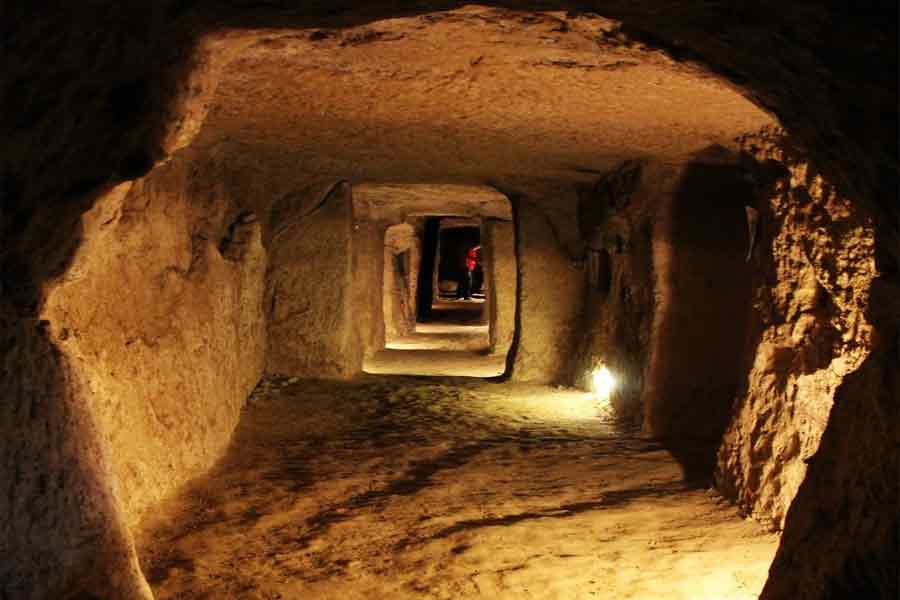
SIALK HILLS
No one knew it was there, only a flood was needed to reveal the 7500-year-old story of Sialk Hills from farmlands. At first glance, it might seem that this place is only ruined, but if you look closer, you can hear the ancient artifacts will talk to you. Read the following to discover more about this metropolitan and its culture and citizens. Before the great flood that led to Sialk Hills discovery, people of Kashan named this mysterious part of town “The Cursed City” and no one dared to get close to this dreadful place. The word “hills” might not be suitable for describing this structure, it’s actually a Ziggurat (a rectangular stepped tower, sometimes surmounted by a temple) mostly made of clay. After the flood, lots of tools and potteries with different interesting shapes were found. After a while, a famous French archeologist specialist in ancient Persia from The Louvre Museum named Roman Ghirshman travel to Iran to start excavation with his team on this unique historical site. As a result of his findings, a large part of Sialk Hills treasure is now held in The Louvre Museum of Paris. Despite Ghrishman’s findings and research results which were published as two books in French, no one paid attention to Sialk Hills until 2001, when Dr. Malek shahmirzadi started new excavations in five sessions. Sialk Hills was excavated three seasons by Ghrishman and five seasons by Dr. Malekshahi. The findings were both amazing and interesting. Ghrishman has estimated that this civilization has more than 10000 years old. The excavations revealed that there are six main levels and therefore eras in two main parts of Sialk Hills (northern hill and southern hill) that each has its unique exclusivity
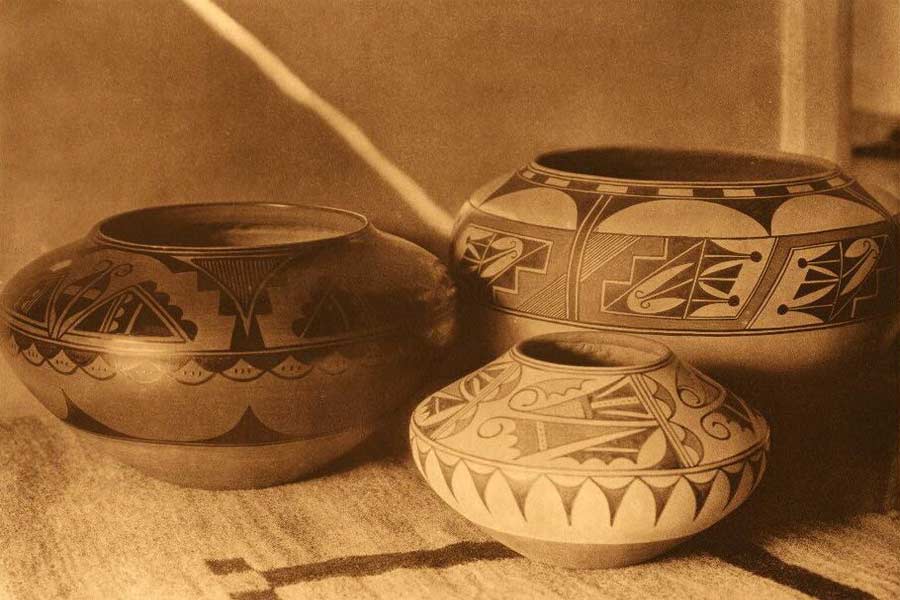
MARANJAB DESERT
Listening to the sound of the night, feel the world moving, counting stars; who doesn’t want these moments? The Maranjab Desert can offer you all of these unique, memorable, and unforgettable experiences. This natural phenomenon is located in Isfahan Province and near the fantastic city of Kashan. With huge sand dunes, salt lake, spectacular nights, and almost easy access, Maranjab is one of the most popular desserts in Iran. If you go about 60 Km toward north-east of Kashan and north of Aran va Bidgol, you can reach this place. Although it has a harsh environment, you can find plenty of salt-friendly plants in this desert. Besides, it is home to some of the desert birds and reptiles like eagles, snakes, and lizards. So, better to watch out. It is not really an island, instead of water, you will find salt. It is located in the heart of Maranjab Desert. There is an old saying that indicates this place is constantly moving, that is why they call it Wandering Island. If you watch this mysterious place from distance, it looks like a giant ship in the middle of a sea of sands. You might be surprised to hear that in some times of the year it is raining in this dessert! Due to precipitation, the level of water rises in this area and you can see fantastic views of Maranjab Desert.
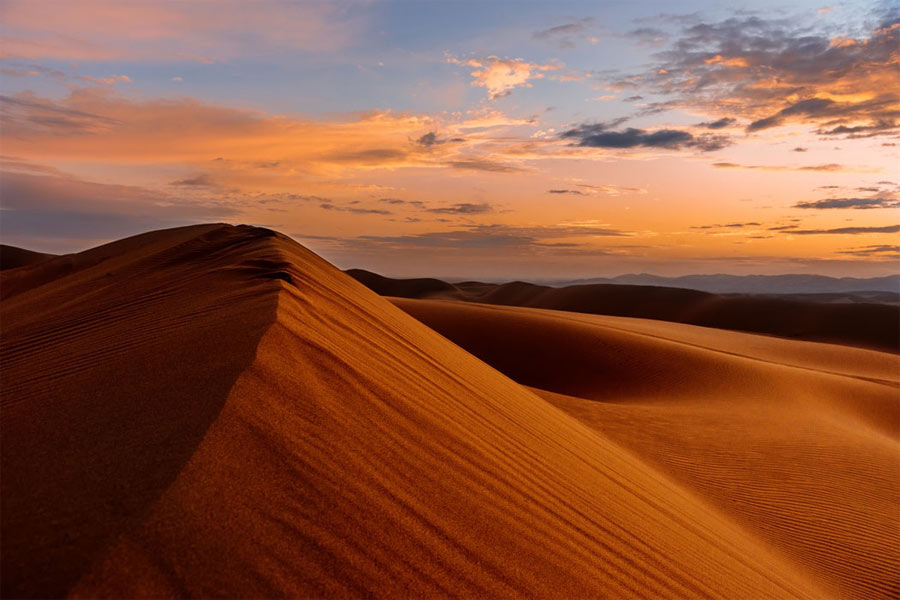
ABYANEH VILLAGE
The smell of roses in the air, the wind dancing through the willows, cozy little stair-like red houses, people with traditional patterned clothes with their charming accent. You can find all of these in Abyaneh! One of the loveliest villages in Iran. In a world that traditions are losing the battle to globalization, seeing an intact authentic community is truly blessed. Stunning Abyaneh Village was built on the foothills of Karkas Mountain, right in central Iran, in Isfahan province. There is no concrete evidence that shows us how old is this beauty, but archaeologists estimated that it should be more than 2500 years old. They also found several historical sites near the village belong to Seljuk Empire, Sassanid Empire, Safavid Dynasty, and Qajar Dynasty. So, not only this village has cultural attractions, but the historical as well. People of Abyaneh call the village as Viona, meaning a place filled with willow trees. This place is located about 2222 meters above the sea line, so you can imagine how pleasant it would be to be surrounded by willow trees while a lovely breeze touches your skin. One of the amazing things that you will definitely find interesting in Abyaneh is its architecture, making it one of the top three touristic villages in Iran along with Masouleh and Kandovan. Abyaneh has stair-shape houses, meaning that the houses were built in a way that the roof of the lower house is also the yard for the above house! Isn’t it fascinating? Not to mention the usage of clay in houses that gives the village a vibrant and lively look. Maybe these exclusivities evolved the unique culture of Abyaneh as well, the closeness and sharing of neighbors with the passion and warmness of red color. Abyaneh people have their unique culture, completely different from any other place nearby. They have their own accent, clothes, house, and traditions. Besides the architectural differences that have mentioned, clothing is another cultural element that you will notice instantly. It is commonly thought that they are older people who preserve the traditions, but not in Abyaneh case! People in Abyaneh, from all age ranges, wear the village traditional clothes; even little children. Women Clothing in Abyaneh includes dress, Shaliteh (a kind of skirt), scarf, headband, socks, footwear or Giveh (is a kind of soft, comfortable, durable and hand-woven-top shoe common in several parts of Iran). The dress is loose and long. Shaliteh is a loose skirt that is tied with a waistband and so many pleats. Accordingly, 7 to 8 meters of cloth is used for a skirt. The clothes they use in Shaliteh is mostly made of colorful canvas or cotton. Additionally, they use special, colorful, and shiny ribbons and stripes that they sew on the skirt (Called “Navar Douzi” and “Roban Douzi” in Persian). They also use square shape scarfs (1.5*1.5 meter square) and they fold and put on the triangle shaped scarf. Men have their special clothes as well. They wear long loose black trousers
